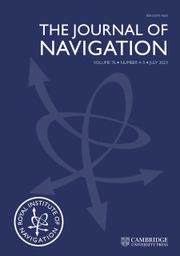No CrossRef data available.
Article contents
Terrain matching without redundant 3D Zernike moments
Published online by Cambridge University Press: 22 August 2025
Abstract
Terrain-aided navigation with a three-dimensional (3D) map has both high accuracy and high reliability, which is crucial for applications in the global navigation satellite system (GNSS)-denied scenarios. In this paper, a new terrain matching algorithm with 3D Zernike moments (3D ZMs) is proposed. The redundant items in the even-order 3D ZMs are analysed in theory. The 3D ZMs are also correlated with the standard deviations of terrain further to identify the redundant items. The new 3D ZM descriptors are proposed for the feature vector of the matching algorithm by excluding the redundant items from the descriptors. The simulation results demonstrate that the algorithm with the revised descriptors achieves a higher matching success rate than both that with the existing descriptors and that with the odd-order descriptors under the same conditions.
Information
- Type
- Research Article
- Information
- Copyright
- © The Author(s), 2025. Published by Cambridge University Press on behalf of The Royal Institute of Navigation


